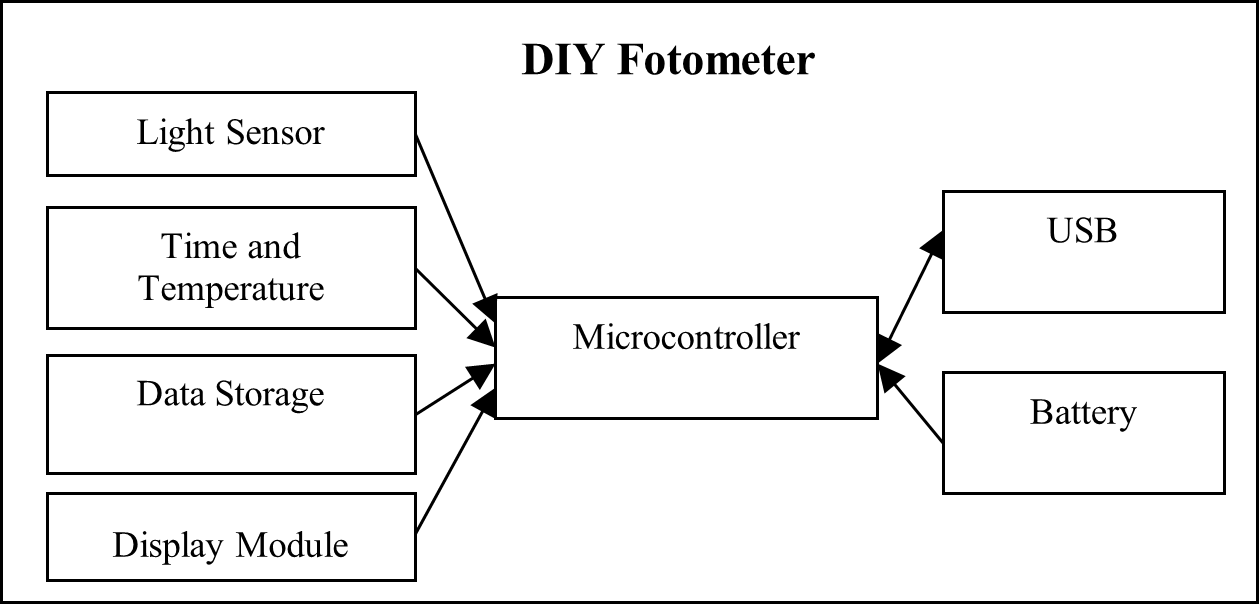DIY photometer for night sky brightness in earth & space laboratory
DOI:
https://doi.org/10.12928/jrkpf.v9i2.167Keywords:
photometer, sky quality meter, night sky brightnessAbstract
A photometer is a tool that can be used as a medium for learning, practicum, and research to study the quality of the night sky in Astrophysics courses. The photometry practicum provides work principles, tool settings, and data collection knowledge. Currently, the Earth and Space Laboratory of the Department of Physics Education has only one photometer. When used, it must be connected to a computer because there is no internal power, and it can not store data. This resulted in the photometry practicum failing to run optimally. Therefore, it is necessary to have the right solution to maintain the essence of practicum as the basis of knowledge, namely, to make your photometer called Do It Yourself (DIY). The method used in this study is an experimental method with data collection. Starting with a needs analysis, then the design of the photometer is carried out. This was followed by making a photometer and conducting a limited trial by measuring the Night Sky Brightness (NSB). The results showed that DIY Photometer functionally could measure the quality of the night sky. Also can show the same pattern as the measurement results using the manufacturer's SQM-LU so that the DIY Photometer that has been made can be used in photometry practicum activities in Astrophysics courses or other similar subjects.
References
I. Ibrahim, H. L. Malasan, C. Kunjaya, A. T. Jaelani, G. Puannandra Putri, and M. Djamal, “Statistical improvement in detection level of gravitational microlensing events from their light curves,” Res. Astron. Astrophys., vol. 18, no. 4, p. 041, Apr. 2018, https://doi.org/10.1088/1674-4527/18/4/41.
M. R. Alarcon, M. Puig-Subirà, M. Serra-Ricart, S. Lemes-Perera, M. Mallorquín, and C. López, “SG-WAS: A New Wireless Autonomous Night Sky Brightness Sensor,” Sensors, vol. 21, no. 16, p. 5590, Aug. 2021, https://doi.org/10.3390/s21165590.
J. Zamorano et al., “Testing sky brightness models against radial dependency: A dense two dimensional survey around the city of Madrid, Spain,” J. Quant. Spectrosc. Radiat. Transf., vol. 181, pp. 52–66, Sep. 2016, https://doi.org/10.1016/j.jqsrt.2016.02.029.
D. Herdiwijaya, “On the beginning of the morning twilight based on sky brightness measurements,” J. Phys. Conf. Ser., vol. 1523, no. 1, p. 012007, Apr. 2020, https://doi.org/10.1088/1742-6596/1523/1/012007.
N. F. Ngadiman, N. N. M. Shariff, and Z. S. Hamidi, “Light Pollution: A Preliminary Study in Kundasang, Sabah Based on Sky Quality Meter System,” J. Phys. Conf. Ser., vol. 1593, no. 1, p. 012023, Jul. 2020, https://doi.org/10.1088/1742-6596/1593/1/012023.
C. P. Asmoro et al., “The Assembled Solar Eclipse Package (ASEP) in Bangka Indonesia during the total solar eclipse on March 9, 2016,” J. Phys. Conf. Ser., vol. 771, p. 012020, Nov. 2016, https://doi.org/10.1088/1742-6596/771/1/012020.
A. F. C. Wijaya et al., “Zenith sky brightness and celestial objects visibility during total solar eclipse on March 9, 2016 at Terentang Beach Bangka Island,” J. Phys. Conf. Ser., vol. 771, p. 012012, Nov. 2016, https://doi.org/10.1088/1742-6596/771/1/012012.
Y. Pramudya and M. Arkanuddin, “The sky brightness measurement during the 2016 solar eclipse in Ternate,” J. Phys. Conf. Ser., vol. 771, p. 012013, Nov. 2016, https://doi.org/10.1088/1742-6596/771/1/012013.
A. J. Rakhmadi, H. R. Setiawan, and A. Y. Raisal, “Pengukuran Tingkat Polusi Cahaya dan Awal Waktu Subuh di OIF UMSU dengan Menggunakan Sky Quality Meter,” Titian Ilmu J. Ilm. Multi Sci., vol. 12, no. 2, Sep. 2020, https://doi.org/10.30599/jti.v12i2.667.
P. Cinzano, “Night Sky Photometry with Sky Quality Meter,” 2005. [Online]. Available: http://www.lightpollution.it/download/sqmreport.pdf.
Unihedron, “SQM-LU Operator’s Manual,” 2011. http://unihedron.com.
C. P. Asmoro and H. Susanti, “Analysis of Do-it-Yourself (DIY) Electrode for Soil Resistivity Measurement Practical of Geology and Geophysics Subject at Earth and Outerspace Laboratory,” J. Temapela, vol. 3, no. 1, pp. 10–18, Nov. 2020, https://doi.org/10.25077/temapela.3.1.10-18.2020.
C. P. Asmoro, H. Susanti, and N. D. Ardi, “Rekontruksi Set Alat Praktikum Geolistrik pada Matakuliah Eksplorasi Geofisika di Departemen Pendidikan Fisika Universitas Pendidikan Indonesia,” Wahana Fis., vol. 5, no. 2, pp. 125–135, Dec. 2020, https://doi.org/10.17509/wafi.v5i2.28765.
A. S. Wicaksana, “Perancangan Alat Ukur Kekeruhan Pada Air Kolam Menggunakan Optocoupler (Sensor Turbidity) Berbasis Arduino,” Universitas 17 Agustus 1945 Surabaya, 2018.
N. F. Ngadiman, N. N. M., Shariff, and Z. S., Hamidi, “Sensor Technology for Night Sky Brightness Measurements in Malaysia,” Int. J. Recent Technol. Eng., vol. 8, no. 6, pp. 198–202, Mar. 2020, https://doi.org/10.35940/ijrte.D9721.038620.
J. Zamorano, C. García, C. Tapia, A. Sánchez de Miguel, S. Pascual, and J. Gallego, “STARS4ALL Night Sky Brightness Photometer,” Int. J. Sustain. Light., vol. 18, pp. 49–54, Jun. 2017, https://doi.org/10.26607/ijsl.v18i0.21.
A. T. Fitri, I. K. Bachtiar, and T. Suhendra, “Pengaruh Radiasi Matahari Terhadap Arus Phototransistor,” Student Online J. , pp. 1–9, 2021, [Online]. Available: https://soj.umrah.ac.id/index.php/SOJFT/article/view/868%0Ahttps://soj.umrah.ac.id/index.php/SOJFT/article/download/868/750.
Daniel, “DIY Astronomer,” 2021. https://stargazerslounge.com/profile/28724-corpze/.
Miguel Martinez-Ledesma and Fabio Falchi, “Spectral and Zonal Restriction Justification - Review Process of DS043 / 2012 MMA ( Ministry of Environment ),” no. November, pp. 1–37, 2019.
J. E. Bortle, Introducing The Bortle Dark-Sky Scale. Sky & Telescope, 2001.

Downloads
Published
Issue
Section
License
Copyright (c) 2022 Cahyo Puji Asmoro, Hana Susanti , Judhistira Aria Utama

This work is licensed under a Creative Commons Attribution-NonCommercial 4.0 International License.







